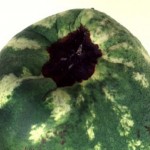Causal Agent: (physiological ‑ water stress)
Browning and shriveling occur at the blossom end of melon (Image 1), followed by a secondary decay caused by microorganisms that progresses inward. It is caused by a calcium deficiency in the fruit and occurs in plants subjected to drought stress. Cultivars can differ in their susceptibility to the problem. Watering operations that avoid drought stress can reduce or eliminate the problem. Excess nitrogen fertilizer may also contribute to blossom-end rot.

